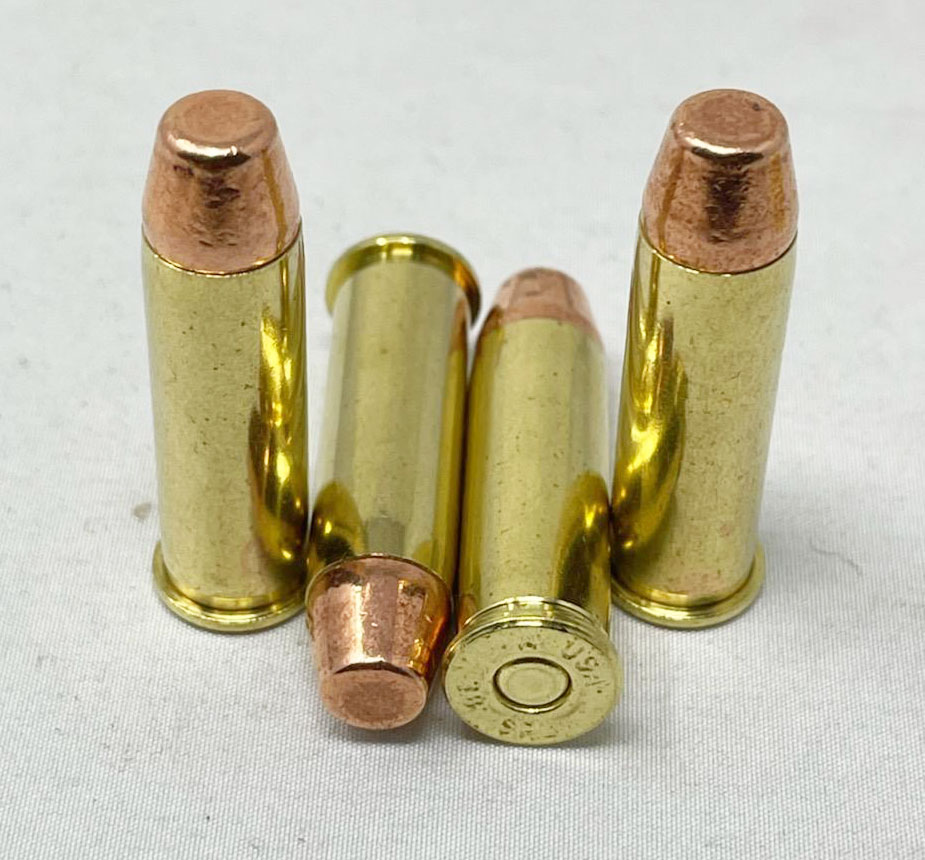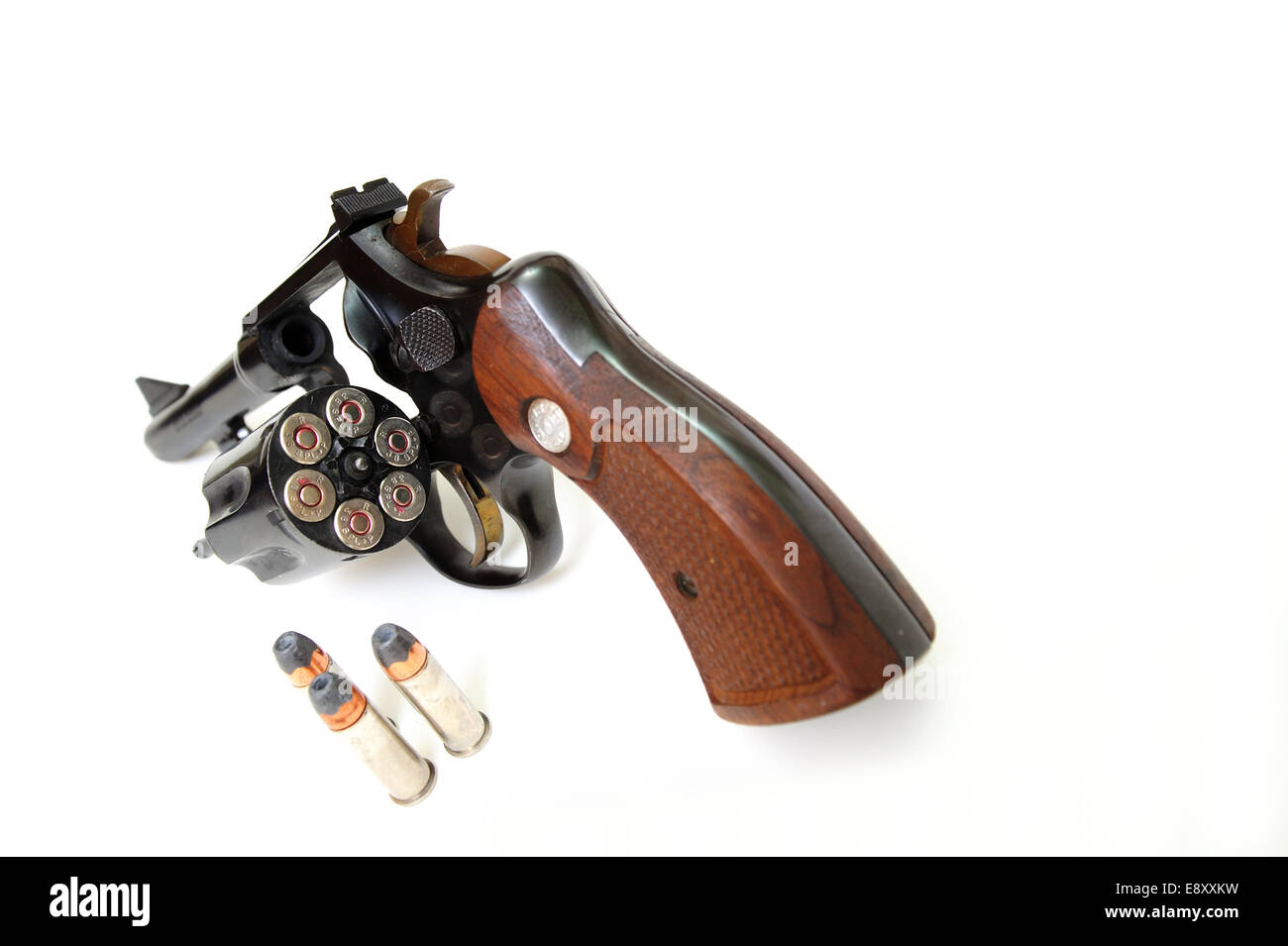Caliber 38 Special - Most stories start from the beginning. To tell the story of the .38 Smith & Wesson Special cartridge, however, it is necessary to return, first, to steel cartridge weapons.
Some of the diameters that are still with us today became standard when smooth muzzle loading cases were also measured in "width" or "bore". These numbers mean the number of round lead balls of the hole diameter needed to make one pound. The 0.72 inch "12-bore" was, of course, popular with the 18th century and is still with us as a rifle. However, the 50, 60, 100, and 150 bores still carry over, as they operate in the diameters we all know today.
Caliber 38 Special

It was the 100-bore caliber that became popular in Colt's first percussion revolver, the .36 caliber Paterson revolver. When the Republic of Texas Navy ordered the 180 .36 Paterson, it was Sam Colt's first major military sale. The same size continued to be used in the Colt 1851 "Navy" revolvers, which were common in the post-Civil War West, and were eventually formalized in the first double-action revolver with a solid frame and a tipping the man for us is general. US Army issue, Colt M1892.
Vs. 38 Special
The cartridge in this revolver was known as the .38 Long Colt, and its first combat debut in the Spanish-American War was less than stellar. Smith & Wesson, working on a new cartridge that would be loaded for the service cartridge, immediately changed their plans.
S&W's new medium-frame revolver (known as a "K-frame" in Smith-Speak) replaced the Colt's pivoting cylinder and manual ejection, leading it to be called the "Hand Ejector" as opposed to the older Smiths. of upper-break, which is automatically ejected the shell when broken.
"Advertising literature of the day boasted that it launched a bullet capable of breaking 8 and a half 7/8-inch plates, 125 percent more than the Colt's competitor."
Instead of the new revolver powder in .38 Long Colt, S&W developed a new cartridge of the same design but with the bullet weight increased from 150 to 158 grains and the powder charge also increased from 18 to 21½ grains of black powder. The resulting round, called the .38 Smith & Wesson Special, boasts a significant performance boost. Marketing brochures of the day boasted that it launched a bullet powerful enough to split eight and a half 7/8-inch pine boards, 125 percent more than the Colt competition. The cartridge was quickly converted to the new smokeless powder, although it retained the 158-grain lead round nose (LRN).
The Revolver Buyer's Guide
Perhaps in anticipation of future sales success, Smith named the new K-frame manual ejector "Military & Policeman." Although no one knows when the first M&Ps hit store shelves in the last year of the 19th century, the next century's mass performance and defense gun/cartridge combination has arrived. For most of the next eight decades, the medium-frame .38 Special Smith would be Good Guy's signature gun.
But things got off to a slow start. The soldier played around with some of Colt's larger rounds before getting the M1911 pistol. The first few years of sales of the .38 M&P Smith produced approximately 20,000 .38 Specials, with orders of a thousand guns each to the Army and Navy. Sales soon increased, and the .38 Special 158-grain LRN eventually became the reference revolver cartridge for many years.
The first major difference on the .38 Special formula came almost three years after the cartridge was made. The Great Depression and Prohibition brought about the era of motorcycle outlawry, and American gun manufacturers were pressed to deliver handguns that could defeat the heavy duty bodies and bulletproof vests of the time. Colt changed their .38 ACP to .38 Super, while Smith & Wesson decided to turbocharge their popular .38 Special.

The result is the .38/44 Heavy Duty, a serial number indicating that it was only intended to be fired in the first large-frame revolvers intended for the .44 Special round. It offers a claimed velocity of over 1100 feet per second. Since the cases are the same size as a regular .38 Special, it would be possible to fire them in an M-frame M&P, although this would not be recommended. At best, it will lead to premature wear, and at worst, damage to the gun and the shooter. It eventually led to the development of the .357 Magnum.
Oak Island Ammunition
At the same time, heavier bullets were tried to increase the performance of the standard .38 Special against automatic bodies. These 200-grain flatpoint loads are referred to by many manufacturers as ".38 Super Police" or ".38 Highway Patrol" loads. They stayed on the market for a while but never replaced the basic 158-grain LRN.
The next major variation of the .38 Special occurred in the 1950s. During World War II, the British Army changed its issued revolver cartridge from the original lead round tip to a steel-jacketed bullet for fear that the soft lead projectile can run afoul of the Hague Declaration of 1899 drawing large bullets. Despite sporting a steel-jacketed ball, the US military's standard .38 LRN-158-grain load remained throughout the war. After the war, the USAF fleet, which issued special .38 rounds to airmen and Defense Police, decided to hedge their bets and shop around for a jacketed .38 round. The result was the 130-grain FMJ, which ran about fifty feet per second faster than the old 158-grain LRN. This is also a common load for sale at indoor ranges for air quality reasons and tends to print less from fixed sight guns.
Things were pretty good in driving throughout the 1950s and into the 1960s, but there would be big changes in self-defense weaponry following the 1960s and 1970s riots.
In the early 1970s, the new .38 special collection made waves as many police departments adopted it. The 158-grain semi-wadcutter hollow point (LSWCHP) loaded to +P pressures was probably first adopted by the St. Louis Police Department. Louis. Many other big cities followed: Albuquerque, Chicago, Dallas, Miami, to name a few. Then the Federal Bureau of Investigation came on board, all but sealing the name around as "FBI Justice."
Rock Island 51283 Revolver M206 *ca Compliant* Single/double 38 Special 2\
"The broad gallants have been described as 'unruly' or 'deadly.' In response to all the national talk about empty spaces, Public Safety Commissioner Reginald Eaves in my city of Atlanta asked the APD to produce low-speed wadcutters, which the police and some newspaper writers mocked as " Reggie Pellets.”
With almost 200 feet per minute more than the traditional 158-grain LRN featuring a hollow point bullet, the 158gr +P LSWCHP developed a reputation for being a more effective combat stop than the old muzzleloader. In addition, the acquisition of this collection by large city police and the FBI helped speed up the process of widespread ammunition modernization for law enforcement and, by extension, use by armed citizens.
For those who weren't around at the time, this is a pretty big deal. The media, not well versed in the technology of weapons, came in full color and cried out against the "Dum-Dum" bullets, as they called them, presenting them with the Indian weapon of It is a British manufactured weapon that has been planted with the same name. Expanded bullets have been described as "invalid" or "lethal". In response to the whole country's talk about space stations, Public Safety Commissioner Reginald Eaves in my hometown of Atlanta raised the issue of low-speed APDs, shunned by police and some newspaper writers as "Reggie Pellets." Fortunately, they were soon removed.

Alternatives to the 158-grain LRN began to appear on the landscape in search of improved terminal performance. The lightweight JHP 110 grain loaded beyond the SAAMI +P threshold has been popularized by the Treasury Department and its umbrella agencies such as the BATF. This is the "stock load" or "Q load" of 110 + P+ seeds. A lightweight and high-charge bullet designed for a rapid charge that engages the gun quickly, with near-magnum levels of muzzle blast. The logic behind the 110-grain JHP+P+ was that the agency wanted .357 Magnum performance without the political stigma (at the time) of issuing .357 Magnum revolvers. Remember, everyone is still getting used to the concept of empty space! The Stock Payload is also used by the Border Patrol and the California Highway Patrol.
Cal Decorator Bullets
As the 70s turned into the 80s, the .38 special continued to evolve as a defensive cartridge, but its days of dominance were also coming to an end. Many arms have adopted the .357 Magnum, bad PR be damned. More importantly, the idea that the police have been "outgunned" by the bad guys will lead to even greater changes in the .38 market.
Be sure to check out our Ballistic Gelatin test to find out how some old favorites .38 Special loads compare to today's hollow point bullets. We use cookies on this website, our own and those of third parties, to improve your user experience. By
Sig p365 tulster holster, sig p365 iwb holster, sig holsters p365, sig p365 sas holster, sig p365 xl holster, sig p365 hybrid holster, appendix holster sig p365, safariland holster sig p365, sig p365 belt holster, sig p365 holster, sig p365 purse holster, sig sauer p365 holster
0 Comments